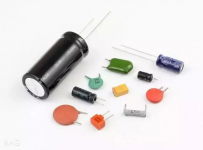
Detailed knowledge point data collection description of capacitors and capacitors
“I believe everyone is familiar with capacitors. Even if you have never seen them, you have heard of them. In today’s life, capacitors are one of the indispensable components, ranging from large circuits to small Electronic motherboards, especially single-phase motors. To start, no capacitor is needed. The so-called capacitor is an electronic component that holds and releases electric charge. The electric charge will be moved by force in the electric field. When there is a medium between the conductors, it will hinder the movement of the electric charge and cause the electric charge to accumulate on the conductor; the most common example of the accumulation and storage of electric charge is two parallel metal plates.
“
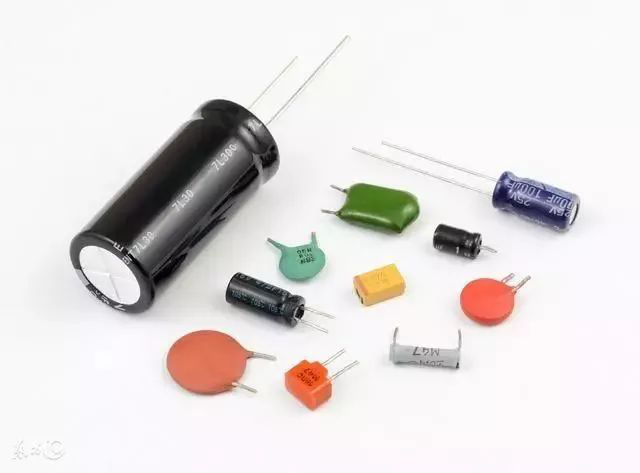
I believe everyone is familiar with capacitors. Even if you have never seen them, you have heard of them. In today’s life, capacitors are one of the indispensable components, ranging from large circuits to small electronic motherboards, especially single-phase motors. To start, no capacitor is needed. The so-called capacitor is an electronic component that holds and releases electric charge. The electric charge will be moved by force in the electric field. When there is a medium between the conductors, it will hinder the movement of the electric charge and cause the electric charge to accumulate on the conductor; the most common example of the accumulation and storage of electric charge is two parallel metal plates.
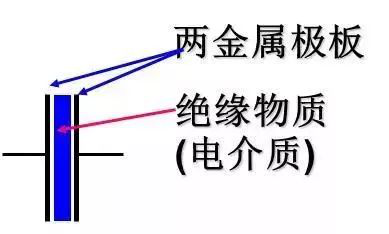
A layer of insulating material (dielectric) is sandwiched between two opposite parallel metal plates to form the simplest capacitor, which is called a parallel plate capacitor. The two metal plates are called the plates of the capacitor. Any two conductors that are insulated from each other and are very close to each other can be regarded as a capacitor.
How Capacitors Work
The principle of capacitors is also very simple. For example, in the water pipe at home, the water supply end will travel long distances, and the water volume will inevitably fluctuate from time to time. If it is directly supplied to the user, it will feel that the water is large and small. Usually, the water company will build a water tower every other distance. The function of this water tower is to store water, which can stably deliver unstable water to every household.
This water tower corresponds to the capacitor in electronics. The function of the capacitor is to store energy, which can convert unstable electrical energy into stable electrical energy and transmit it to the circuit. The ideal capacitor itself does not consume electrical energy, it will release as much electrical energy as it absorbs. When the input voltage fluctuates, the capacitor will generate current, because it will be charged or discharged. When the voltage is stable, no current will be generated, which is called “blocking DC and AC”.
Charging of capacitors
Connect the two poles of the capacitor to the positive and negative poles of the battery, and the two poles will be charged with the same amount of different charges respectively. This process is called charging, and there is a short charging current in the circuit during the charging process.
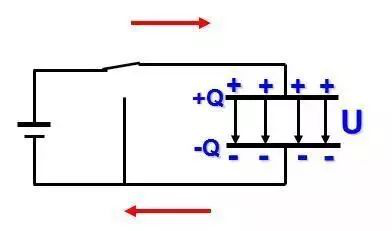
A charged capacitor, there is an electric field between the two plates, the potential difference U, the electric energy obtained from the power supply is stored in the electric field, this energy is called electric field energy. Capacitors have the ability to store charge and electric field energy.
discharge of capacitors
Connect the two poles of the charged capacitor, the charge on the two poles is neutralized, and the capacitor is no longer charged. This process is called discharge, and there is a short discharge current.
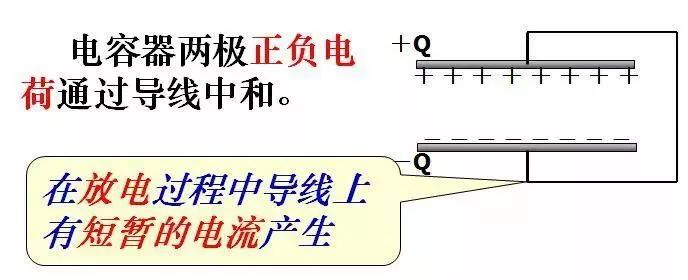
After discharge, there is no electric field and potential difference between the two polar plates, and the electric field can be converted into other forms of energy.
The main function of capacitors
1. Coupling:
The capacitor used in the coupling circuit is called coupling capacitor, which is widely used in resistance-capacitance coupling amplifiers and other capacitive coupling circuits to block DC and AC.
2. Filter:
The capacitor used in the filter circuit is called a filter capacitor. This capacitor circuit is used in power supply filtering and various filter circuits. The filter capacitor removes the signal in a certain frequency band from the total signal.
3. Decoupling:
Capacitors used in decoupling circuits are called decoupling capacitors and are used in the DC voltage supply circuit of multi-stage amplifiers. Decoupling capacitors eliminate harmful low-frequency cross-connections between each stage of amplifiers.
4. High frequency vibration damping:
The capacitor used in the high-frequency vibration elimination circuit is called the high-frequency vibration elimination capacitor. In the audio negative feedback amplifier, in order to eliminate the high frequency self-excitation that may occur, this capacitor circuit is used to eliminate the high frequency whistle that the amplifier may appear. .
5. Resonance:
Capacitors used in LC resonant circuits are called resonant capacitors, which are required in both LC parallel and series resonant circuits.
6. Bypass:
The capacitor used in the bypass circuit is called the bypass capacitor. If the signal of a certain frequency band needs to be removed from the signal in the circuit, the bypass capacitor circuit can be used. ) bypass capacitor circuit and high frequency bypass capacitor circuit.
7. Neutralization:
Capacitors used in neutralizing circuits are called neutralizing capacitors. In radio high-frequency and intermediate-frequency amplifiers, and television high-frequency amplifiers, this neutralizing capacitor circuit is used to eliminate self-excitation.
8. Timing:
Capacitors used in timing circuits are called timing capacitors. Timing capacitor circuits are used in circuits that require time control through capacitor charging and discharging, and capacitors play a role in controlling the size of the time constant.
9. Points:
Capacitors used in integrating circuits are called integrating capacitors. In the synchronizing separation circuit of potential field scanning, using this integrating capacitor circuit, the field synchronizing signal can be extracted from the field composite synchronizing signal.
10. Differentiation:
Capacitors used in differential circuits are called differential capacitors. In order to obtain the peak trigger signal in the trigger circuit, this differential capacitor circuit is used to obtain the peak pulse trigger signal from various (mainly rectangular pulse) signals.
11. Compensation:
The capacitor used in the compensation circuit is called a compensation capacitor. In the bass compensation circuit of the deck, this low-frequency compensation capacitor circuit is used to enhance the low-frequency signal in the playback signal. In addition, there is a high-frequency compensation capacitor circuit.
12. Bootstrapping:
The capacitor used in the bootstrap circuit is called a bootstrap capacitor. The commonly used OTL power amplifier output stage circuit adopts this bootstrap capacitor circuit to increase the amplitude of the positive half cycle of the signal by a small amount through positive feedback.
13. Frequency division:
The capacitor in the frequency division circuit is called the frequency division capacitor. In the speaker frequency division circuit of the speaker, the frequency division capacitor circuit is used so that the high frequency speaker works in the high frequency band, the intermediate frequency speaker works in the middle frequency band, and the low frequency speaker works in the low frequency band. frequency band.
The labeling method of the main parameters of the capacitor
Direct method
Electrolytic capacitors or larger non-polar capacitors: nominal capacity, rated voltage and allowable deviation.
Small non-polar capacitors: nominal capacity, rated voltage and allowable deviation.
Capacity unit: microfarads (μF), {farads (nF), picofarads (pF)
Such as: 1p2 means 1.2 pF; 1n means 1 000 pF; 10n means 0.01 μF; 2μ2 means 2.2 μF.
digital labeling
The digital labeling method is generally a three-digit number to indicate the capacity of the capacitor, in pF. The first two digits are the effective digits of the capacitance, and the third digit is the multiplier, but when the third digit multiplier is 9, it means ×10 -1.
like:?
101? ? means: 10 × 101 = 100 pF
102? ? means: 10 × 102 = 1 000 pF
103? ? means: 10 × 103 = 0.01μF
104? ? means: 10 × 104 = 0.1μF
223? ? means: 10 × 103 = 0.022μF
474? ? means: 10 × 104 = 0.47μF
159? ? means: 10 × 10C1 = 1.5 pF
color scale
Color scale method: mark the color circle or color point on the capacitor to indicate the capacitance and allowable deviation.
Four-ring color scale method: the first and second rings represent the effective value, the third ring represents the multiplier, and the fourth ring represents the allowable deviation (common capacitor).
Five-ring color scale method: the first, second, and third rings represent the effective value, the fourth ring represents the multiplier, and the fifth ring represents the allowable deviation (precision capacitor).
like:
Brown, black, orange, gold ? ? means its capacitance is 0.01 μF, and the allowable deviation is ±5%
Brown, black, black, red, brown? ? means its capacitance is 0.01 μF, and the allowable deviation is ±1%
Classification and function of capacitors
Ceramic capacitors (CC)

Structure: Using ceramic material as the medium, coating a layer of metal (silver) film on the surface of the ceramic, and then sintering at high temperature as an electrode. Ceramic capacitors are divided into Class 1 dielectrics (NPO, CCG); Class 2 dielectrics (X7R, 2X1) and Class 3 dielectrics (Y5V, 2F4) ceramic capacitors.
Uses: Mainly used in high frequency circuits.
Polyester Capacitor (CL)
![]()
Structure: Polyester capacitors are non-polar capacitors with a positive temperature coefficient (that is, when the temperature increases, the capacitance becomes larger) made of polar polyester film as the medium.
Uses: Generally used in medium and low frequency circuits.
Commonly used models are CL11, CL21 and other series.
Polystyrene Capacitors (CB)
![]()
Structure: There are two types of foil type and metallized type.
Uses: Generally used in medium and high frequency circuits.
Commonly used models are CB10, CB11 (non-sealed foil type), CB14~16 (precision type), CB24, CB25 (non-sealed metallization), CB80 (high pressure type), CB40 (sealed metallization) and other series.
Polypropylene Capacitors (CBB)
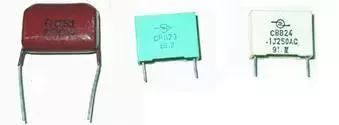
Structure: A negative temperature coefficient non-polar capacitor made of non-polar polypropylene film as the medium. There are two types of unsealed (commonly encapsulated with colored resin paint) and sealed (encapsulated with metal or plastic housing).
Uses: Generally used in medium and low frequency electronic circuits or as starting capacitors for motors.
Commonly used foil polypropylene capacitors: CBB10, CBB11, CBB60, CBB61, etc.; metallized polypropylene capacitors: CBB20, CBB21, CBB401 and other series.
Monolithic capacitors
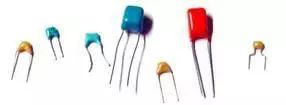
Structure: Monolithic capacitors are multi-layer ultra-small capacitors made of barium titanate-based ceramic materials sintered.
Uses: Widely used in resonance, bypass, coupling, filtering, etc.
Commonly used are CT4 (low frequency), CT42 (low frequency); CC4 (high frequency), CC42 (high frequency) and other series.
Mica Capacitors (CY)

Structure: Mica capacitors use mica as a medium, spray a layer of metal film (silver) on the mica surface as an electrode, lamination according to the required capacity, and then dipping and compression molding in a bakelite shell (or ceramic or plastic shell) to form.
Uses: Generally used for signal coupling, bypassing, tuning, etc. in high-frequency circuits.
Commonly used are CY, CYZ, CYRX and other series.
Paper capacitors (CZ)
![]()
Structure: Paper-based capacitors are made of thin capacitor-specific paper as the medium and aluminum foil or lead foil as the electrodes, which are rolled, formed, impregnated and then packaged.
Disadvantages: large volume, low capacity accuracy, large loss, and poor stability.
Commonly there are CZ11, CZ30, CZ31, CZ32, CZ40, CZ80 and other series.
Metallized Paper Capacitors (CJ)
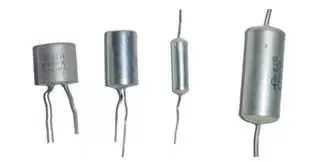
Structure: Metallized paper capacitors are made by vacuum evaporation technology, and a layer of metal film is evaporated on the paper coated with paint film as electrodes.
Advantages: Compared with ordinary paper capacitors, it is small in size, large in capacity, and has strong self-healing ability after breakdown.
Common CJ10, CJ11 and other series.
Aluminum Electrolytic Capacitors (CD)
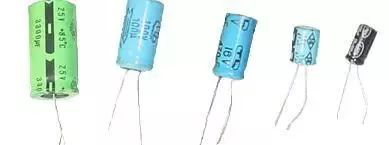
Structure: Polarized aluminum electrolytic capacitors are made by winding aluminum foil (positive electrode) with oxide film and liner paper impregnated with electrolyte solution together with cathode (negative electrode) foil laminations. Appearance package has tube type and vertical type. And there is a blue or black plastic cover outside the aluminum shell.
Uses: Usually used in DC power circuits or medium and low frequency circuits for filtering, decoupling, signal coupling, time constant setting, and DC blocking.
Tantalum Electrolytic Capacitors (CA)
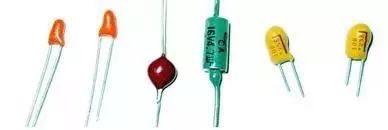
Structure: There are two forms: 1. Foil-type tantalum electrolytic capacitor, with a wound core inside, the negative electrode is liquid electrolyte, and the medium is tantalum oxide. Models are CA30, CA31, CA35, CAk35 and other series. 2. Tantalum powder sintering type, the anode (positive electrode) is made of tantalum powder with very fine particles and then sintered. There are various packaging forms.
Models are CA40, CA41, CA42, CA42H, CA49, CA70 (non-polar) and other series.
Mica Trimmer Capacitors (CY)
![]()
Structure: The mica fine-tuning capacitor is composed of a fixed piece and a moving piece. The fixed piece is a fixed metal piece, and a layer of mica flakes is pasted on its surface as a medium. The moving piece is an elastic copper or aluminum piece. Adjust the moving piece by adjusting the screw on the moving piece. The distance between the plate and the fixed plate changes the capacitance. Mica trimmer capacitors are divided into single trimmer and double trimmer.
Uses: used in transistor radios, electronic instruments, and electronic equipment.
Ceramic trimmer capacitors (CC)
![]()
Structure: Ceramic trimmer capacitors use ceramics as the medium. A semicircular silver layer is plated on both the moving piece (ceramic piece) and the fixed piece (ceramic piece), and the size of the capacitance can be changed by changing the relative position between the two silver pieces by rotating the moving piece.
Uses: used in transistor radios, electronic instruments, and electronic equipment.
Film trimmer capacitors
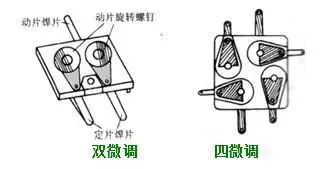
Structure: Film trimmer capacitors use organic plastic film as the medium, that is, add organic plastic film between the moving piece and the stator (both moving and stationary are semi-circular metal pieces), and adjust the screws on the moving piece to make the moving piece. Rotate to change capacity.
Film trimmer capacitors are generally divided into double trimmers and quadruple trimmers. Some sealed double-connected or sealed four-connected variable capacitors have their own film trimmer capacitors, and the trimmer capacitors are installed on the top of the casing, which is more convenient to use and adjust.
Air Variable Capacitors (CB)
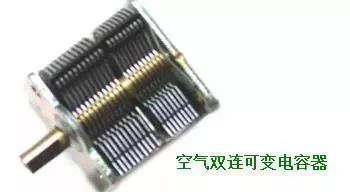
Structure: The electrode consists of two sets of metal sheets. One set is the fixed piece, the other is the moving piece, and the air is used as the medium between the moving piece and the fixed piece. When the rotor is rotated to make it all screw into the stator, its capacitance is the largest, on the contrary, when the rotor is fully screwed out of the stator, the capacitance is the smallest.
Air variable capacitors are divided into single-connection and double-connection.
Film Variable Capacitors
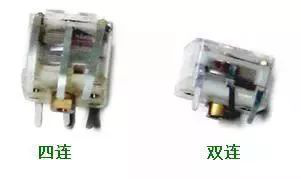
Structure: The film variable capacitor is a plastic film as a medium between the moving piece and the stator, and the outer shell is a transparent or translucent plastic package, so it is also called a sealed single-connection or sealed double-connected and sealed four-connection variable capacitors.
Uses: Single connection is mainly used in simple radios or electronic instruments; double connection is used in transistor radios and electronic instruments and electronic equipment; quadruple connection is commonly used in AF/FM multi-band radios.
The Links: LM150X08-A4K9 2MBI450U4E-120 TIMMALCD



